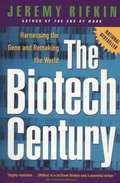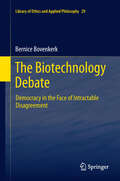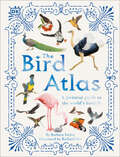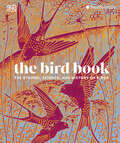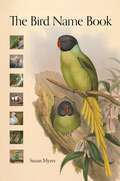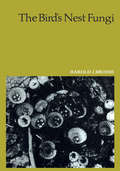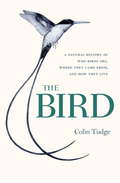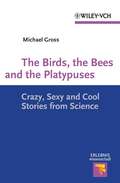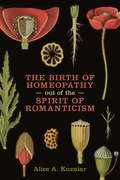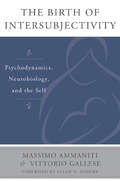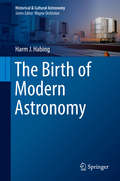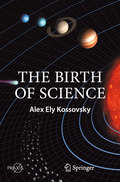- Table View
- List View
The Biotech Century: Harnessing the Gene and Remaking the World
by Jeremy RifkinIn this seminal book, Jeremy Rifkin explores the epic marriage between computer technology and genetic engineering, and the historic transition into the Age of Biotechnology. Already, Rifkin explains, our economy is undergoing a massive shift away from the Industrial Age and into an era in which giant life-science corporations are fashioning a bioindustrial world. Humanity is on the brink of wielding greater control over the shape of life--how we are born; how our food supply is created; the traits our children may have--than has ever been imagined. But with each step into this new era, we must ask ourselves: At what cost?
The Biotechnology Debate
by Bernice BovenkerkThis book grounds deliberative democratic theory in a more refined understanding of deliberative practice, in particular when dealing with intractable moral disagreement regarding novel technologies. While there is an ongoing, vibrant debate about the theoretical merits of deliberative democracy on the one hand, and more recently, empirical studies of specific deliberative exercises have been carried out, these two discussions fail to speak to one another. Debates about animal and plant biotechnology are examined as a paradigmatic case for intractable disagreement in today's pluralistic societies. This examination reveals that the disagreements in this debate are multi-faceted and multi-dimensional and can often be traced to fundamental disagreements about values or worldviews. "One of the acute insights to emerge from this examination is that deliberation can serve different purposes vis-à-vis different types of problem. In the case of deeply unstructured problems, like the modern biotechnology debate, the aim of inclusion is more appropriate than the aim of consensus. This book highlights the importance of political culture and broader institutional settings in shaping the capacity and propensity of citizens to engage in deliberation and the degree to which governments are prepared to relinquish authority to deliberative mini-publics." Robyn Eckersley, University of Melbourne, Australia
The Bird Alphabet Book (Jerry Pallotta's Alphabet Books)
by Jerry PallottaReady to go birding? Quick! Can you think of a bird whose name begins with X? Jerry Pallotta found one, and also birds for Q and Z and all the other letters of the alphabet.But this isn't a simple "A is for Atlantic Puffin" kind of alphabet book. Find out where these birds live, how they survive, and the unique qualities that make them interesting. Full of facts and fun, this book is sure to intrigue children with its array of feathered friends, from the familiar to the exotic. Take a brilliant tour of the bird world.
The Bird Atlas (DK Pictorial Atlases)
by Barbara TaylorTake a peek inside the beautiful and absorbing world of birds with this lavishly illustrated children&’s bird atlas.From the Amazon Rainforest to the Rocky Mountains, this fully-fledged children&’s bird guide will take you on a guided tour, continent by continent, to meet some of the most spectacular birds in the world! Get ready to journey through different biomes, like rivers and desserts, to discover fun facts about birds that will fascinate and inspire every budding ornithologist. In this bird book for kids, you&’ll learn why flamingos are pink, why birds migrate and who migrates the farthest, and which bird species are endangered.Packed with hundreds of incredible, life-like illustrations, this educational book is a pictorial guide to the birds of the world. It showcases birds from every continent as you&’ve never seen before with detailed maps pinpointing where different species of birds can be found. See magnificent snowy owls in the Arctic, tiny three-wattled bellbirds in the Caribbean, towering ostriches in Africa, and gorgeous depictions of the flighty American Robin. A Truly Breathtaking Celebration of BirdlifeThe Bird Atlas is arranged in order of continent - Europe, Asia, Africa, Australasia, North America, South America, and Antarctica. Every continent is introduced with an overview of the ecology, climate, and landscape, and the typical and incredible birds that live there. This children&’s book is the perfect introduction to our feathered friends and makes a great gift for the new generation of birdwatchers.Inside the pages of this children&’s atlas, you&’ll discover: • Fascinating facts about birds, from why vultures are bald to how bald eagles actually aren&’t • Why some species are endangered and what can be done to protect them • Birds that can be found in different countries and continents of the world, their habitat, geography, and climate More from DK Books:Don&’t miss out on more fascinating atlases! After exploring this fascinating bird book for kids, your child can move on to The Body Atlas to discover the inner workings of the human body. Next up is The Animal Atlas that takes children on a tour to meet the animals of the world.
The Bird Book: The Stories, Science, and History of Birds
by DKDelve into the fascinating world of birds through astonishing photography and clear explanations in this absorbing global guideBirds are dinosaurs, with a history going back millions of years. Our fascination with them runs deep in history and our close association is reflected in creation stories, myths, legends, songs, and children's stories.This book explores both the natural history of birds and that deep cultural connection. From their evolution and anatomy to their behavior and diversity, spanning tiny dunnocks hiding in bushes to ostriches strong enough to knock out a lion. Articles cover a group, such as hawks, finches, swans, or birds of paradise, moving the focus away from a predictable species-by-species account and allowing for truly global coverage. Discover the bold nature of European Robins and why they are associated with Christmas; the mythical Alkonost, with the body of a bird of paradise but the head of a woman; and learn about eagles, from their hunting prowess to the myriad stories and symbolism associated with them. Packed with information, and beautiful photography and illustrations, The Bird Book is a must-have for nature enthusiasts.
The Bird Name Book: A History of English Bird Names
by Susan MyersA marvelously illustrated A-to-Z compendium of bird names from around the globeThe Bird Name Book is an alphabetical reference book on the origins and meanings of common group bird names, from “accentor” to “zeledonia.” A cornucopia of engaging facts and anecdotes, this superbly researched compendium presents a wealth of incisive entries alongside stunning photos by the author and beautiful historic prints and watercolors. Myers provides brief biographies of prominent figures in ornithology—such as John Gould, John Latham, Alfred Newton, and Robert Ridgway—and goes on to describe the etymological history of every common group bird name found in standardized English. She interweaves the stories behind the names with quotes from publications dating back to the 1400s, illuminating the shared evolution of language and our relationships with birds, and rooting the names in the history of ornithological discovery.Whether you are a well-traveled birder or have ever wondered how the birds in your backyard got their names, The Bird Name Book is an ideal companion.
The Bird Way: A New Look at How Birds Talk, Work, Play, Parent, and Think
by Jennifer AckermanFrom the New York Times bestselling author of The Genius of Birds, a radical investigation into the bird way of being, and the recent scientific research that is dramatically shifting our understanding of birds -- how they live and how they think.&“There is the mammal way and there is the bird way.&” But the bird way is much more than a unique pattern of brain wiring, and lately, scientists have taken a new look at bird behaviors they have, for years, dismissed as anomalies or mysteries –– What they are finding is upending the traditional view of how birds conduct their lives, how they communicate, forage, court, breed, survive. They are also revealing the remarkable intelligence underlying these activities, abilities we once considered uniquely our own: deception, manipulation, cheating, kidnapping, infanticide, but also ingenious communication between species, cooperation, collaboration, altruism, culture, and play. Some of these extraordinary behaviors are biological conundrums that seem to push the edges of, well, birdness: a mother bird that kills her own infant sons, and another that selflessly tends to the young of other birds as if they were her own; a bird that collaborates in an extraordinary way with one species—ours—but parasitizes another in gruesome fashion; birds that give gifts and birds that steal; birds that dance or drum, that paint their creations or paint themselves; birds that build walls of sound to keep out intruders and birds that summon playmates with a special call—and may hold the secret to our own penchant for playfulness and the evolution of laughter. Drawing on personal observations, the latest science, and her bird-related travel around the world, from the tropical rainforests of eastern Australia and the remote woodlands of northern Japan, to the rolling hills of lower Austria and the islands of Alaska&’s Kachemak Bay, Jennifer Ackerman shows there is clearly no single bird way of being. In every respect, in plumage, form, song, flight, lifestyle, niche, and behavior, birds vary. It is what we love about them. As E.O Wilson once said, when you have seen one bird, you have not seen them all.
The Bird's Nest Fungi
by Harold J. BrodieThe intriguing Bird's Nest Fungi (Nidulariaceae) of forest, meadow, and garden have been familiar to botanists since 1601, but only relatively recently has the significance of their peculiar form been realized. Dr Brodie traces the long controversy that arose when Bird's Nest Fungi were first classified as seed plants because of the numerous seed-like bodies contained in their small cup-shaped fruit bodies. The 'seeds' are now known to contain spores like those of other fungi such as puffballs, to which the Nidulariaceae are related. Present-day research has shown that certain Bird's Nest Fungi produce chemicals having previously unrecognized molecular structure. Between these milestones Dr Brodie reveals the solution to the mystery of the dispersal of the 'eggs' from the 'bird's nest': the fruit bodies are splash guns from which the reproductive spores are ejected by the force of falling raindrops. This explanation of the phenomenon is supported by copious observations and hitherto unpublished experiments.All known species of Nidulariaceae, including many only recently recognized, are described in this volume. All aspects of growth, structure, development, and life-cycle of these fungi, both in nature and in laboratory culture, are reported in a modern, comprehensive treatment of a subject which is of interest not only to mycologists but to amateur naturalists as well.
The Bird: A Natural History of Who Birds Are, Where They Came From, and How They Live
by Colin TudgeOriginally published: Consider the birds: who they are and what they do. London: Allen Lane, 2008.
The Birds, the Bees and the Platypuses: Crazy, Sexy and Cool Stories from Science (Erlebnis Wissenschaft)
by Michael GrossMichael Gross has been writing about science full time for the last eight years and as a night time hobby for the previous seven. From his treasure troves, he now presents his favourite science stories from these 15 years. What are the attractions that make him revisit a topic or reread an article again and again? Often, it's the sheer craziness of wildly unexpected findings or grotesquely oversized challenges. In other stories, there is a sexy element or an unexpected insight into the human condition. And sometimes, when reporting new and future technologies, the author just can't help thinking: >cooooooool!< So here are more than 60 crazy, sexy and cool science stories for you to enjoy.
The Birth of Computer Vision
by James E. DobsonA revealing genealogy of image-recognition techniques and technologies Today&’s most advanced neural networks and sophisticated image-analysis methods come from 1950s and &’60s Cold War culture—and many biases and ways of understanding the world from that era persist along with them. Aerial surveillance and reconnaissance shaped all of the technologies that we now refer to as computer vision, including facial recognition. The Birth of Computer Vision uncovers these histories and finds connections between the algorithms, people, and politics at the core of automating perception today.James E. Dobson reveals how new forms of computerized surveillance systems, high-tech policing, and automated decision-making systems have become entangled, functioning together as a new technological apparatus of social control. Tracing the development of a series of important computer-vision algorithms, he uncovers the ideas, worrisome military origins, and lingering goals reproduced within the code and the products based on it, examining how they became linked to one another and repurposed for domestic and commercial uses. Dobson includes analysis of the Shakey Project, which produced the first semi-autonomous robot, and the impact of student protest in the early 1970s at Stanford University, as well as recovering the computer vision–related aspects of Frank Rosenblatt&’s Perceptron as the crucial link between machine learning and computer vision.Motivated by the ongoing use of these major algorithms and methods, The Birth of Computer Vision chronicles the foundations of computer vision and artificial intelligence, its major transformations, and the questionable legacy of its origins. Cover alt text: Two overlapping circles in cream and violet, with black background. Top is a printed circuit with camera eye; below a person at a 1977 computer.
The Birth of Homeopathy out of the Spirit of Romanticism
by Alice KuzniarHomeopathy was founded in 1796 by the German physician Samuel Hahnemann who ardently proposed that "like cures like," counter to the conventional treatment of prescribing drugs that have the opposite effect to symptoms. Alice A. Kuzniar critically examines the alternative medical practice of homeopathy within the Romantic culture in which it arose. In The Birth of Homeopathy out of the Spirit of Romanticism, Kuzniar argues that Hahnemann was a product of his time rather than an iconoclast and visionary. It is the first book in English to examine Hahnemann’s unpublished writings, including case journals and self-testings, and links to his contemporaries such as Goethe and Alexander von Humboldt. Kuzniar’s engaging writing style seamlessly weaves together medical, philosophical, semiotic, and literary concerns and reveals homeopathy as a phenomenon of its time. The Birth of Homeopathy out of the Spirit of Romanticism sheds light on issues that continue to dominate the controversy surrounding homeopathy to this very day.
The Birth of Intersubjectivity: Psychodynamics, Neurobiology, and the Self
by Massimo Ammaniti Vittorio GalleseNeurobiological research helps explain the experience of motherhood. This book, the exciting collaboration of a developmental psychoanalyst at the forefront of functional magnetic resonance attachment research and a leading neurobiological researcher on mirror neurons, presents a fresh and innovative look at intersubjectivity from a neurobiological and developmental perspective. Grounding their analysis of intersubjectivity in the newest advances from developmental neuroscience, modern attachment theory, and relational psychoanalysis, Massimo Ammaniti and Vittorio Gallese illustrate how brain development changes simultaneously with relationally induced alterations in the subjectivities of both mother and infant. Ammaniti and Gallese combine extensive current interdisciplinary research with in-depth clinical interviews that highlight the expectant mother's changing subjective states and the various typologies of maternal representations. Building on Gallese's seminal work with mirror neurons and embodied simulation theory, the authors construct a model of intersubjectivity that stresses not symbolic representations but intercorporeality from a second-person perspective. Charting the prenatal and perinatal events that serve as the neurobiological foundation for postnatal reciprocal affective communications, they conclude with direct clinical applications of early assessments and interventions, including interventions with pregnant mothers. This volume is essential for clinicians specializing in attachment disorders and relational trauma, child psychotherapists, infant mental health workers, pediatricians, psychoanalysts, and developmental researchers. It combines fascinating new information and illustrative clinical experience to illustrate the early intersubjective origins of our own and our patients' internal worlds.
The Birth of Modern Astronomy (Historical & Cultural Astronomy)
by Harm J. HabingThis richly illustrated book discusses the ways in which astronomy expanded after 1945 from a modest discipline to a robust and modern science. It begins with an introduction to the state of astronomy in 1945 before recounting how in the following years, initial observations were made in hitherto unexplored ranges of wavelengths, such as X-radiation, infrared radiation and radio waves. These led to the serendipitous discovery of more than a dozen new phenomena, including quasars and neutron stars, that each triggered a new area of research. <P><P> The book goes on to discuss how after 1985, the further, systematic exploration of the earlier discoveries led to long-term planning and the construction of new, large telescopes on Earth and in Space. Key scientific highlights described in the text are the detection of exoplanets (1995), the unexpected discovery of the accelerated expansion of the Universe (1999), a generally accepted model for the large-scale properties of the Universe (2003) and the ΛCDM theory (2005) that explains how the galaxies and stars of the present Universe were formed from minute irregularities in the (almost) homogenous gas that filled the early Universe. <P><P> All these major scientific achievements came at a price, namely the need to introduce two new phenomena that are as yet unexplained by physics: inflation and dark energy. Probably the deepest unsolved question has to be: Why did all of this start with a Big Bang?
The Birth of Modern Science
by Paolo RossiOne of a series on the historic development of Europe, covers the development of science.
The Birth of Science (Springer Praxis Books)
by Alex Ely KossovskyThis book reveals the multi-generational process involved in humanity's first major scientific achievement, namely the discovery of modern physics, and examines the personal lives of six of the intellectual giants involved. It explores the profound revolution in the way of thinking, and in particular the successful refutation of the school of thought inherited from the Greeks, which focused on the perfection and immutability of the celestial world. In addition, the emergence of the scientific method and the adoption of mathematics as the central tool in scientific endeavors are discussed. The book then explores the delicate thread between pure philosophy, grand unifying theories, and verifiable real-life scientific facts. Lastly, it turns to Kepler’s crucial 3rd law and shows how it was derived from a mere six data points, corresponding to the six planets known at the time. Written in a straightforward and accessible style, the book will inform and fascinate all aficionados of science, history, philosophy, and, in particular, astronomy.
The Birth of Star Clusters
by Steven StahlerAll stars are born in groups. Accordingly, the origin of stellar groups is a central issue not only in star formation studies, but also in other fields of astrophysics, including cosmology. This volume summarizes modern research into this venerable question. Observers and theorists who are active in the field offer perspectives on how clusters arise not only in various regions of the Milky Way, but also in the distant galaxies that have been probed by the Hubble Space Telescope, among other instruments. The range of physical conditions varies widely, but the essential question remains the same. How do diffuse clouds of gas condense into the collections of luminous objects we call stars?
The Birth of the Living God: A Psychoanalytic Study
by Ana-Marie Rizzuto M.D.Utilizing both clinical material based on the life histories of twenty patients and theoretical insights from the works of Freud, Erikson, Fairbairn, and Winnicott, Ana-Maria Rizzuto examines the origin, development, and use of our God images. Whereas Freud postulated that belief in God is based on a child's idea of his father, Rizzuto argues that the God representation draws from a variety of sources and is a major element in the fabric of one's view of self, others, and the world.
The Birth of the Pill: How Four Crusaders Reinvented Sex and Launched a Revolution
by Jonathan EigA Chicago Tribune 'Best Books of 2014' A Washington Post '50 Notable Works of Nonfiction & Best Science Books 2014' A Chicago Tribune 'Nonfiction Books to Gift 2014' A Slate 'Best Books 2014: Staff Picks' A Booklist '2014 Editor's Choice' & 'Top 10 Science and Health Books of 2014' A St. Louis Post-Dispatch 'Best Books of 2014: Nonfiction' The fascinating story of one of the most important scientific discoveries of the twentieth century. We know it simply as "the pill," yet its genesis was anything but simple. Jonathan Eig's masterful narrative revolves around four principal characters: the fiery feminist Margaret Sanger, who was a champion of birth control in her campaign for the rights of women but neglected her own children in pursuit of free love; the beautiful Katharine McCormick, who owed her fortune to her wealthy husband, the son of the founder of International Harvester and a schizophrenic; the visionary scientist Gregory Pincus, who was dismissed by Harvard in the 1930s as a result of his experimentation with in vitro fertilization but who, after he was approached by Sanger and McCormick, grew obsessed with the idea of inventing a drug that could stop ovulation; and the telegenic John Rock, a Catholic doctor from Boston who battled his own church to become an enormously effective advocate in the effort to win public approval for the drug that would be marketed by Searle as Enovid. Spanning the years from Sanger's heady Greenwich Village days in the early twentieth century to trial tests in Puerto Rico in the 1950s to the cusp of the sexual revolution in the 1960s, this is a grand story of radical feminist politics, scientific ingenuity, establishment opposition, and, ultimately, a sea change in social attitudes. Brilliantly researched and briskly written, The Birth of the Pill is gripping social, cultural, and scientific history.
The Birthday Blastoff (Kate the Chemist)
by Kate BiberdorfThe fourth installment of the Kate the Chemist fiction series that shows kids that everyone can be a scientist! Perfect for fans of the Girls Who Code series.When Kate's brother Liam is having a science-themed birthday party the very same day that the science club in Kate's school is planning a special rocket launch experiment, Kate isn't sure how she'll manage to do it all: be a great big sister AND a great science club member. But with a little help from chemistry--and her friends--Kate figures out a way to be in two places at once. That is, until she is late to pick up the ice cream cake, which means Liam won't have a birthday cake for his party! Will science be able to save the day?From Kate the Chemist, chemistry professor and science entertainer as seen on The Late Show with Stephen Colbert, The Wendy Williams Show, and The Today Show, comes a clever and fun middle grade series that is the perfect introduction to STEM for young readers!Make Your Own Rocket! Experiment Inside! Praise for Dragons vs. Unicorns:"Proves that science and fun go together like molecules in a polymer."--School Library Journal"It's a great introduction to the basics of Chemistry that is readily accessible to a variety of ages . . . . The way the everyday chemistry is blended in is done seamlessly, and has [me and my ten-year-old son] noticing how we are all doing a little bit of science every day." --GeekMom.com
The Birthday Castle: Fort Builders Inc. 1 (QUIX)
by Dee RomitoA group of friends use teamwork, creativity, and construction know-how to start their own fort building company in the first story in a new, fun-to-read Aladdin QUIX chapter book series that&’s perfect for emerging readers!Caleb could really use a bit more spending money—he needs to buy the next book in his favorite series so he can see what happens! But what can he do to raise funds once his allowance runs out? Caleb puts his head together with his best friend, Jax, and a couple other kids in their neighborhood, and come up with a brilliant idea. They&’re going to start their own fort-building business! Good forts are always in demand, and who better to design and construct them than kids? But when Fort Builders, Inc., gets their first gig, the group has trouble agreeing on the right way to go about it. Can they learn to work together in time to build an incredible fort, or will their business be over before it even begins?
The Bitter Gourd Genome (Compendium of Plant Genomes)
by Chittaranjan Kole Hideo Matsumura Tusar Kanti BeheraThis book focusing on the bitter gourd genome is the first comprehensive compilation of knowledge on the botany, cytogenetical analysis, genetic resources and diversity, traditional breeding, tissue culture and genetic transformation, whole genome sequencing and comparative genomics in the Cucurbitaceae family. It discusses the biochemical profile of the bioactives present in this horticultural crop, used both as a vegetable and as a medicine, and also addresses sex determination in bitter gourd. Written by respected international experts, the book is useful to students, teachers and scientists in academia, as well as seed companies and pharmaceutical industries.
The Black Box of Biology: A History of the Molecular Revolution
by Michel MorangeIn this masterful account, a historian of science surveys the molecular biology revolution, its origin and continuing impact. Since the 1930s, a molecular vision has been transforming biology. Michel Morange provides an incisive and overarching history of this transformation, from the early attempts to explain organisms by the structure of their chemical components, to the birth and consolidation of genetics, to the latest technologies and discoveries enabled by the new science of life. Morange revisits A History of Molecular Biology and offers new insights from the past twenty years into his analysis. The Black Box of Biology shows that what led to the incredible transformation of biology was not a simple accumulation of new results, but the molecularization of a large part of biology. In fact, Morange argues, the greatest biological achievements of the past few decades should still be understood within the molecular paradigm. What has happened is not the displacement of molecular biology by other techniques and avenues of research, but rather the fusion of molecular principles and concepts with those of other disciplines, including genetics, physics, structural chemistry, and computational biology. This has produced decisive changes, including the discoveries of regulatory RNAs, the development of massive scientific programs such as human genome sequencing, and the emergence of synthetic biology, systems biology, and epigenetics. Original, persuasive, and breathtaking in its scope, The Black Box of Biology sets a new standard for the history of the ongoing molecular revolution.
The Black Flies of Subtropical and Tropical Asia: Taxonomy and Biology
by Hiroyuki TakaokaThis book uncovers the entire picture of the black fly (Diptera: Simuliidae) fauna in subtropical and tropical Asia (the Oriental Region). Increased discoveries of new species of black flies in the Oriental Region have disclosed a remarkable diversity in terms of phylogenetic lineages and morphological features, particularly adult genitalia and pupal gills. The black fly fauna in the Oriental Region is found to be completely different from those in other regions. The book has two aims, academic and practical. Introduction provides the general information on the biology and effects on human and animal health and welfare of black flies and introduces the unique characteristics of the black fly fauna in this region. Part I proposes a classification scheme for all 671 named and 45 unnamed species of Oriental black flies, which are placed 11 subgenera and 36 species-groups of the genus Simulium. In Part II, synoptic accounts are given for their distribution, bionomics, and taxonomic comments of all the species. In Part III, the faunas of black flies in 15 countries or areas [India, Nepal, Bhutan, Sri Lanka, Myanmar, Thailand, Peninsular Malaysia, Borneo, Sunda Archipelago (Sumatra, Java, Bali, Lombok, Sumbawa, Flores and Timor), East Indonesia (Sulawesi, Maluku Islands and Irian Jaya), Vietnam, Philippines, Taiwan, South China, Nansei Islands (Japan)], are overviewed, and species lists and identification keys for females, males, pupae and larvae, are constructed. Ninety-eight figures of 1,691 line-drawings highlight various unique morphological characteristics of most subgenera and species-groups. Parts I and II are academically essential for medical or biological scientists and students to study black flies. Keys to identify species in 15 countries or areas in Part III are of practical use for health workers for the control of insects of medical and veterinary importance, as well as for ecologists for the study of aquatic invertebrates. Many novel morphological characteristics illustrated in the figures appeal to readers and show the importance of biodiversity of natural terrestrial ecosystems. Contents of this book resulted from the author’s taxonomic review of all 716 Oriental species of black flies, with reference to 481 publications.
The Black Hole Information Paradox: A Fifty-Year Journey (Springer Series in Astrophysics and Cosmology)
by Cosimo Bambi Ali AkilThis book reviews a few different derivations of the Hawking radiation, most main solutions to the paradox proposed in the literature, and some analog laboratory experiments. A black hole is an object whose gravity is so strong that nothing, not even light, can escape its grasp. However, applying quantum field theory on a black hole background, Stephen Hawking showed that black holes are not completely black. In fact, they seem to emit a form of radiation that was named the Hawking radiation. The Hawking radiation appears to be thermal and in a quantum state that is independent of the initial state that formed the black hole; instead, it solely depends on the black hole's total mass, spin, and electric charge. A problem arises when we consider an initial system that collapses, forms a black hole, and eventually the black hole evaporates completely through Hawking radiation. Since Hawking radiation depends solely on the black hole's total mass, spin, and electric charge, it implies that numerous distinct initial states could all lead to the same final state. Consequently, the intricate details of the initial state seem to be lost, which contradicts the unitarity of evolution of closed systems, a fundamental principle of quantum mechanics. The unitarity principle implies that closed systems evolve in a reversible manner, such that, knowing a system&’s final state, and the way it evolved, one can always determine its initial state. The many-to-one evolution of the black hole initial state to radiation evolution is in a clear contradiction with this principle. This is the black hole information paradox. The black hole information paradox was found in the 1970s by Stephen Hawking. Over the past 50 years, it has attracted a lot of interest in the theoretical physics community and is still an active research field. Chapters are written by leading experts in the field.
